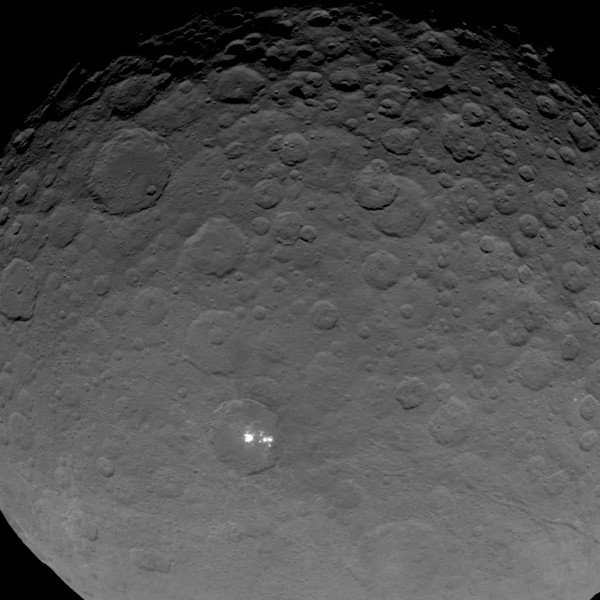As the Dawn spacecraft settles into lower orbits around Ceres the photos of this small world are of ever better resolution. The mysterious bright spots have slowly resolved into an interesting arrangement of multiple spots. Despite many wild claims on YouTube and UFO websites of alien cities or crashed spacecraft, the spots are looking more and more like a set of ice outcroppings. They are still fascinating, if just a bit more ordinary than some would hope.
My bet? Some sort of cryovolcano.
NASA’s Dawn mission captured a sequence of images, taken for navigation purposes, of dwarf planet Ceres on May 16, 2015. The image showcases the group of the brightest spots on Ceres, which continue to mystify scientists. It was taken from a distance of 4,500 miles (7,200 kilometers) and has a resolution of 2,250 feet (700 meters) per pixel.
“Dawn scientists can now conclude that the intense brightness of these spots is due to the reflection of sunlight by highly reflective material on the surface, possibly ice,” Christopher Russell, principal investigator for the Dawn mission from the University of California, Los Angeles, said recently.
Dawn arrived at Ceres on March 6, marking the first time a spacecraft has orbited a dwarf planet. Previously, the spacecraft explored giant asteroid Vesta for 14 months from 2011 to 2012. Dawn has the distinction of being the only spacecraft to orbit two extraterrestrial targets.
The spacecraft has been using its ion propulsion system to maneuver to its second mapping orbit at Ceres, which it will reach on June 6. The spacecraft will remain at a distance of 2,700 miles (4,400 kilometers) from the dwarf planet until June 30. Afterward, it will make its way to lower orbits.

